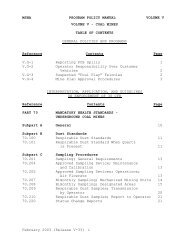MSHA HANDBOOK SERIES - PH13-V-1 - Mine Safety and Health ...
MSHA HANDBOOK SERIES - PH13-V-1 - Mine Safety and Health ...
MSHA HANDBOOK SERIES - PH13-V-1 - Mine Safety and Health ...
Create successful ePaper yourself
Turn your PDF publications into a flip-book with our unique Google optimized e-Paper software.
COAL MINE SAFETY AND HEALTH<br />
GENERAL INSPECTION PROCEDURES <strong>HANDBOOK</strong> CHAPTER 3<br />
conditions noted by the seal examiners recorded in the weekly or preshift<br />
exam books should be investigated. Review seal construction records<br />
under §§ 75.335(c)(1) <strong>and</strong> (2) (Seal strengths, design applications, <strong>and</strong><br />
installations); <strong>and</strong> 75.337(c)(5), (d), <strong>and</strong> (e) (Construction <strong>and</strong> repair of<br />
seals).<br />
2. Inspect safe access for the examiner’s route of travel to <strong>and</strong> from seals. Roof<br />
support must be maintained to provide safe access to the seals. Check for<br />
hazardous conditions, test for methane (CH4) <strong>and</strong> oxygen (O2) deficiency,<br />
<strong>and</strong> determine if the air is moving in the proper direction under<br />
§§ 75.360(b)(5) (Preshift examination at fixed intervals); <strong>and</strong> 75.364(b)(4)<br />
<strong>and</strong> 75.364(c)(3) (Weekly examination).<br />
3. Verify the required operators’ examinations by checking initials, dates, <strong>and</strong><br />
times.<br />
4. Inspect seals for deterioration <strong>and</strong> for damage such as cracking, spalling, or<br />
bulging. Inspect the base of the seal for deterioration due to mine water<br />
<strong>and</strong> floor heave. Although some spalling of ribs <strong>and</strong> sloughing from the<br />
roof may accumulate near the seal, enough of the seal must be kept clear to<br />
facilitate a reasonable visual examination.<br />
5. Inspect the strata surrounding seals for rib sloughing, roof falls or floor<br />
deterioration that may affect the integrity of the seal. Ensure that the seal’s<br />
convergence is being measured <strong>and</strong> that the threshold as per design has not<br />
been exceeded.<br />
6. Evaluate rock dust around the seals <strong>and</strong> in adjacent aircourses.<br />
7. Inspect sampling pipes <strong>and</strong> sample the atmosphere behind the seals. At a<br />
minimum, inspectors should sample at one location at each set of seals.<br />
Seals that have reached a design strength of at least 120 psi overpressure or<br />
greater do not have to be sampled. The determination of seal strength is<br />
based on the quality control test results specified in the seal design under<br />
§ 75.335(b)(1)(i) (Seal strengths, design applications, <strong>and</strong> installations) <strong>and</strong><br />
reported to the District Manager under § 75.337(e)(3) (Construction <strong>and</strong><br />
repair of seals).<br />
Sample the sealed atmosphere whether seals are outgassing or ingassing for<br />
seals with design strength less than 120 psi. Additional sampling locations<br />
may be specified in the approved ventilation plan.<br />
Release 1 (February 2013) 3-53
















